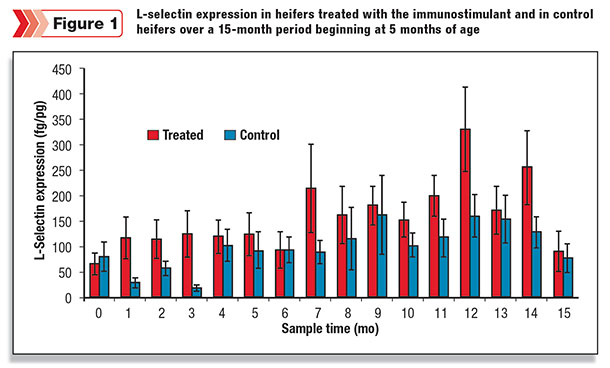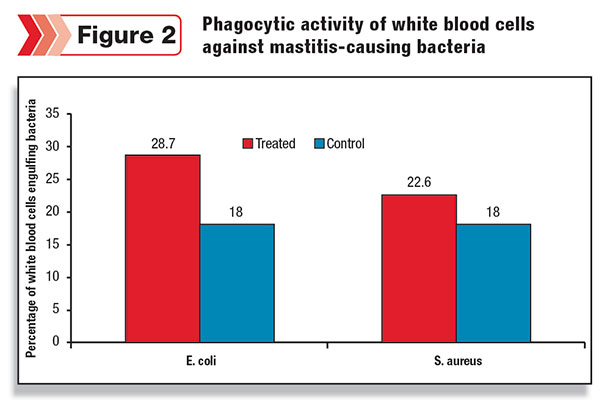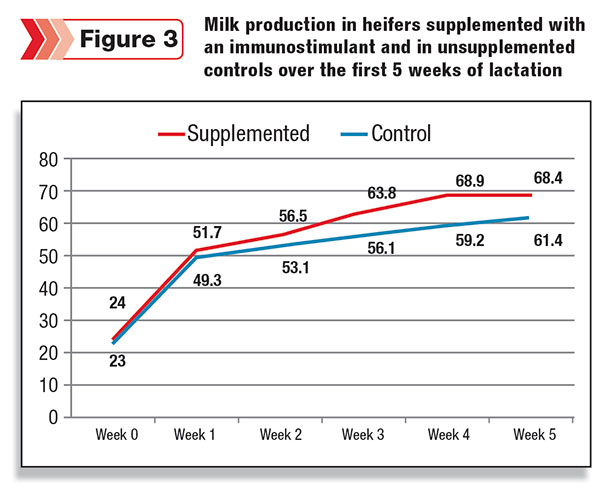As the global need for milk protein and dairy products in general continues to increase, greater expectations are placed on the dairy cow to produce more milk in an efficient manner. Rations are now being formulated to maximize animal health and production by incorporation of feed supplements, such as immune-stimulating additives.
These are substances that enhance the cow’s ability to fight disease, thereby making her more healthy during periods of stress, such as at calving time and during the period of negative energy balance in early lactation. A healthier cow translates into less energy diverted toward disease control, leaving more energy for milk yield, which basically increases the efficiency of production.
Use of dietary immune stimulants may be an alternative to drugs
One such dietary immunostimulant was recently evaluated for its ability to enhance the immune system of dairy heifers as protection against mastitis.
In addition to adult lactating and dry cows, mastitis may be common during gestation in dairy heifers, especially infections caused by Staphylococcus aureus, which result in reduced milk yield and elevated somatic cell counts (SCC), and spread to the lactating herd.
It is imperative that heifers calve free of mastitis with low SCC and maximum production to capitalize on producer profits. To ensure optimum udder health in these young dairy animals at freshening, mastitis control programs based on antimicrobial therapy have been quite successful; however, the goal is to prevent this disease rather than rely on antibiotics to treat existing infections and prevent new ones.
An alternative to drugs for controlling udder infections is to boost the heifer’s general immune system against mastitis-causing bacteria through a management-friendly mechanism such as dietary supplementation.
A series of experiments with a commercially available immunostimulant demonstrated that when fed to heifers at a young age, immunity in these animals was amplified during gestation, they freshened with low levels of mastitis and SCC, and milk production was enhanced.
University study shows promise
In these studies, 40 heifers received the immunostimulant in their feed as a supplement on a daily basis beginning at 5 months old until time of calving, and 40 heifers served as unsupplemented controls.
All heifers were bled prior to trial initiation and monthly thereafter until calving to collect white blood cells for L-selectin and IL-8 mRNA expression, both of which measure innate immunity. For example, L-selectin expression is a measure of the ability of white blood cells to move from the bloodstream into infected tissue to kill bacteria (such as in the mammary gland).
In addition, a subset of 30 heifers was used to determine the phagocytic activity of white blood cells and the production of reactive oxygen species (ROS) before and after feed supplementation. Finally, at calving, the level of mastitis, SCC and milk production in response to the immunostimulant were evaluated.
Results shown in Figure 1 demonstrated that heifers supplemented with the immunostimulant had higher levels of L-selectin expression over a 15-month period beginning at 5 months old (sample time 0) as well as higher levels of IL-8 (not shown).

This suggests a direct relationship between nutrition and the innate immune response, and indicates that the immune systems of supplemented heifers were more prepared to handle disease threats such as mastitis compared with unsupplemented controls.
A subsequent study involving these same heifers showed that during the periparturient period, the expression of white blood cell L-selectin surface markers was greater in supplemented heifers than controls, which indicates they were better able to mount an immune response during the stresses associated with calving, a time when the immune system is usually suppressed.
White blood cells collected from supplemented heifers were more active in engulfing bacteria such as E. coli and Staph. aureus, which also suggests these animals were better able to fight mastitis-causing bacteria ( Figure 2 ). These white blood cells kill pathogens through a process called phagocytosis, which is the actual capture and engulfment of organisms so they can be destroyed by substances called reactive oxygen species.

To evaluate this killing mechanism, a subset of 30 heifers was used. White blood cells harvested from blood samples collected prior to diet assignment (day 0) and at 30 days following initiation of feeding the immunostimulant or control diets were evaluated for their ability to phagocytose E. coli and Staph. aureus.
As expected, on day 0 prior to feeding the supplement, there were no differences in overall phagocytic activities by white blood cells collected from the treated and control heifers.
However, samples collected on day 30 showed increases in phagocytic activity against E. coli among white blood cells collected from heifers fed the immunostimulant compared to controls (28.7 percent versus 18 percent).
Likewise, phagocytic activity against Staph. aureus was greater among white blood cells collected from heifers fed the immunostimulant compared to controls (22.6 percent versus 18 percent).
In order to kill bacteria, white blood cells must produce chemicals (ROS) that are instrumental in directly killing these microbes. Results from these studies showed that white blood cells from supplemented heifers produced greater amounts of these bactericidal chemicals (such as hydrogen peroxide) by 30 days after feeding the immunostimulant, again suggesting greater disease control compared with unsupplemented controls.
The general enhancement of immune function in heifers supplemented with the immunostimulant was likely associated with the reduction in mastitis observed in early lactation.
The prevalence of mastitis among supplemented heifers was 11 percent compared with 20 percent among controls three days into lactation. Likewise, SCC were reduced in supplemented heifers compared with controls (221,000 per ml versus 535,000 per ml) during this time.
Interestingly, both supplemented and control heifers entered lactation producing similar milk yields, although that of supplemented animals (24 pounds) was slightly greater than controls (23 pounds) ( Figure 3 ).

However, during the first few weeks of lactation (the most susceptible time period for development of new IMI), supplemented heifers appeared to remain healthier (less mastitis, lower SCC) and progressively produced a greater daily milk yield than unsupplemented controls through week five postpartum.
For example, by week one, supplemented heifers were producing an average of 2.4 pounds per day more milk than controls. By week three, this difference was 7.7 pounds, and at week five the difference between supplemented and control animals was still 7 pounds.
Conclusions
Although this particular immunostimulant is presently regarded as “experimental,” meaning additional research is needed before recommending, results are promising. The findings listed in this article are supported by similar trials conducted at other universities and research groups.
It is anticipated that as further research is conducted, and as positive results are sanctioned by the scientific community, general dietary feed immune stimulants may become a standard recommendation made by dairy nutritionists. PD
Steve Nickerson has a Ph.D. in dairy science from Virginia Tech and is currently conducting mastitis research at the University of Georgia.

Stephen C. Nickerson
Lactation Physiologist
University of Georgia








